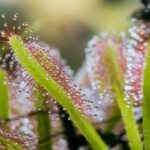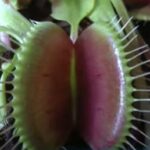As an Amazon Associate, this site earns commissions from qualifying purchases. For more details, click here.
Sundews are known for eating mostly flies, mosquitoes and other flying insects. But can these carnivorous plants also digest spiders? When you see one of these things on your sundew, do you let the plant have it? Or should you remove the bug? If you have always wondered about this, you are in the right place to find the answers.
Sundews eat all kinds of small insects including spiders because they possess nutrients these plants require. However, sundews can only eat small spiders as large species can escape its trap.
How Many Spiders Can Sundews Eat?
The number of spiders sundews can eat depends not just on the size, but how often the plant has already fed. Feeding frequency also determines how quickly a sundew digests its meal.
For optimum growth, sundews should eat once a week or in this case, four spiders a month. This assumes the plant does not eat anything else. If the sundew has already eaten twice this month – regardless of the food- you can only give it two more spiders, one each week.
Managing the feeding frequency is not that difficult. If your sundew is indoors you can easily control its feeding. Now if you keep your drosera outdoors, the plant will not consume more than it can handle. If the sundew is full and a spider lands on its dew, its tentacles will make no attempt to roll over it.
Is One Spider a Week Really Enough?
Because spiders are so small, you are probably wondering if your sundew gets enough nutrition. The answer is yes. A tiny insect like a spider, fly or mosquito provides enough nutrients to last for several days.
One small spider can nourish a sundew plant for a week, which is why feeding four times a month is ideal. As the plant gets older, feeding can be reduced to twice monthly. Reducing the feeding frequency is not required but it can be done without harm.
Large sundews can in theory eat more spiders. But it is better to just give the plant one bug a week to avoid overfeeding. Nutrition is good for sundews, but too much of it might be harmful. If your sundew is not getting enough nourishment from bugs, you can feed it Tetra Freeze Dried Bloodworms because it is as healthy as insects.
Keep in mind these things only apply for indoor sundews that are hand fed. If your plant is outdoors you do not need to do any feeding. There are plenty of spiders, flies and other insects available.
How Do Sundews Digest Spiders?
There are many sundew variants, but their digestive mechanism is basically the same. Their trap only works for small spiders as the large ones will have no trouble getting out.
Sundews produce mucilage, a sticky substance with a sugary scent. This is the glistening stuff you see on the tips of its tentacles and leaves .The mucilage or dew as it is called, serves to lure spiders and other prey.
Spiders can smell the dew even from a distance and they are drawn to it. A spider crawls over the sundew and eats the dew. What it does not realize is that the sticky stuff is a trap. The moment the spider steps on the dew, it gets stuck like fly on flypaper.
As the spider struggles to get free, one or more tentacles squeezes it. These tentacles are filled with mucilage, trapping the spider even more. Eventually the prey expires due to exhaustion or lack of air.
Sundews do not necessarily wait for its prey to die before digesting. As long as the prey is held securely the plant can start eating.
The Sundew Digestion Process
Carnivorous plants do not eat prey the way animals do. Just like Venus flytraps, sundews secrete enzymes that liquefy insect tissues. This only works with small bugs and any hard shell is left out while the rest is dissolved.
These enzymes are spread all over its prey – in this case a spider – and dissolves it. This might take a while depending on its size. The plant absorbs not just the tissues but also the nitrogen and other nutrients in the insect. The enzymes it released are also reabsorbed.
This is the basic digestive process for all sundews. Some variants have additional tentacles that allow it to trap insects more quickly. But the steps towards digestion are similar to others. Whether it is a spider or mealworms from Value Grubs the digestive process is similar. Unlike Venus flytraps, you do not need to simulate the trap. Just drop the food into the dew and the plant does the rest.
Why Sundews Eat Spiders
Sundews are carnivorous plants because they require nutrients. Spiders and other insects are their primary sources of nutrition.
Carnivorous plants like sundews and Venus flytraps grow in poor soil. This is in contrast with most plants that thrive in rich, fertilized soil.
Fertilized soil provides nutrients for plants, from the roots to the leaves. Sundews cannot grow in rich soil but they still need nitrogen, potassium and other nutrients that the ground provides.
Because the soil cannot supply these essentials, sundews have to look elsewhere. Insects, worms and other small animals possess these nutrients. So in time, these plants developed traps to capture these insects and absorb nutrition.
Sundews with proper nutrition can live for decades so it is important that they eat regularly. These nutrients are not food but more like supplements.
Sundew Food vs. Nutrition
Nutrients and food are similar but not the same. Food is the fuel that plants use to perform daily activities, while nutrients supplement their food.
Food for sundews is glucose, which is produced through photosynthesis. Glucose is a sugary substance that plants need. You can think of it as food or fuel for an engine. Either way it is essential for plants to survive.
Nutrition comes in the form of nitrogen and other elements. They serve the same purpose as vitamins and minerals for humans. We take vitamins to make us stronger, more immune to disease and be healthier.
Plants do the same. They extract nutrients from insects and use them to fuel growth, strengthen defenses and produce more dew. While sundews might be able to survive with limited nutrients, they are better off with them.
What to Feed Sundews Besides Spiders
Besides spiders, sundews can eat small insects like flies, wasps, mosquitoes and even amphibians like frogs. Sundews can also eat frozen mealworms and fish food.
Carnivorous plants prefer insects but there is nothing wrong with feeding them worms and fish food. Mealworms are rich in nitrogen just like insects and they are readily available.
The only thing you need to remember is one, make sure the food is small. Second, it must be rich in nitrogen and other nutrients plants need.
This is why hamburgers and other types of human food are not suitable for sundews. Meats for humans contain too much protein, carbohydrates and other stuff sundews do not need.
As long as you stick to insects, fish food or mealworms, feeding will not be a problem. If you cannot find any spiders that is all right. Any small bug will do.
Sundews are not really picky about food and they are easy to feed. As long as the food is small enough the plant can eat it. If you want to give it a large insect however, kill the insect first and chop it into small bits.
What if Sundews Try to Eat Large Bugs?
What will happen if a sundew tries to eat a large spider? At the very least the spider will get away. The worst case scenario is this could kill one of the tentacles or leaves.
The dew and tentacles can only trap small insects. A large spider is not going to get suffocated by the dew and the tentacles cannot hold it down. A large enough prey could rip the tentacles and leaves apart, damaging the plant.
Sundew tentacles that try to eat large bugs will likely turn black and die. The parts which were not eaten will rot and leave an unpleasant smell, so large insects are a no.
Conclusion
Spiders are just one of the many insects that sundews prey on. So you should not worry if you find one of these scurrying along its tentacles. That is good news for your sundew as these creatures are a source of nutrition.

My fascination with carnivorous plants began many, many years ago with Venus Fly Traps. Now I am more than happy to impart what I know with other enthusiasts and those who are curious about meat eating plants.



